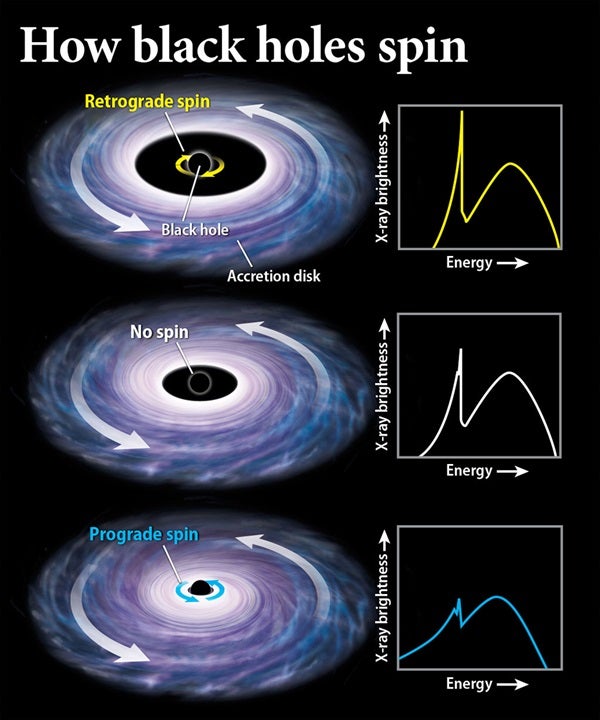Q: What does “black hole spin” mean, and how do astronomers measure it?
A: Like most objects in the universe (planets, stars, asteroids, and other compact objects), black holes rotate. We refer to this property as “spin” or, more formally, its “angular momentum” about its axis of rotation. This concept can be difficult to visualize because a black hole is not a solid body, but it helps if you start by imagining a black hole as the end product of a star’s evolution. If a star begins its life with more than some critical mass (usually estimated at about 10 to 20 times the Sun’s mass), it will ultimately end up as a black hole.
We think all stars spin, and thus so did the sun that collapsed into a remnant black hole. Like a figure skater that pulls her arms in and spins faster, the star’s rate of rotation increases as the star itself gets smaller in radius due to conservation of angular momentum. We aren’t sure exactly how, or how much of, the original star’s rotation is passed to the black hole, but we know that the black hole likely will form with angular momentum.
You can visualize this momentum as the rate of rotation of the black hole’s event horizon, which is the boundary separating the remnant singularity from the outside universe, within which you’d need a velocity greater than the speed of light to escape the black hole’s gravity.
Measuring how fast a black hole spins is important in astronomy for three main reasons. First, spin is one of only two properties that define a black hole (the other is its mass). Second, we think spin is partly responsible for driving energetic outflows — like jets — away from black holes. These outflows can dramatically influence black hole surroundings and even limit their host galaxies’ growth. Finally, supermassive black holes at the centers of galaxies are likely the products of two processes: mergers of many smaller black holes over billions of years and accretion of nearby gas. Measuring the spins of these supermassive black holes can tell us about the relative importance of those two processes.
We can’t see a black hole itself (it’s “black” because no light can escape from it), and we do not yet have the imaging capability to take a picture of the material swirling immediately around one before falling in. But we can measure a black hole’s spin using two indirect techniques, both of which rely on examining X-ray light emitted from gas that is about to fall into the hole. We focus on X-rays because a black hole’s rotation affects only the area nearest to the event horizon, where the gas gives off a lot of high-energy light. Specifically, we analyze the detected amount of a given energy, or radiation wavelength — called a spectrum.
In the first technique, we measure the temperature at the inner portion of the accretion disk that forms as gas swirls toward the event horizon, similar to water swirling down a drain. In the second method, we characterize the precise shape of certain spectral lines emitted from the innermost parts of this accretion disk. Both methods require high-quality X-ray spectral data.
These techniques also require detailed theoretical models that incorporate Albert Einstein’s theory of relativity to extract all the possible information from the data and to get the most precise, accurate constraints on black hole spin. It’s a painstaking process, but so far astronomers have successfully measured such spins in more than 20 supermassive black holes and more than 15 stellar-mass black holes in the past decade.










